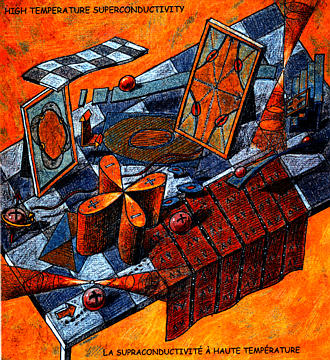
| HOME | DIRECTORY | ACTIVITIES | PROPOSE ACTIVITY | APPLY | FOR VISITORS | ONLINE TALKS | OUTREACH |

|
|||||||||||||||||||||||||
|
|||||||||||||||||||||||||
|
 Although more than a dozen years have passed since its discovery, high Tc superconductivity is still the most active area of research in condensed matter physics. The reason for this intense activity is the widely held belief that high Tc materials represent "new physics," arising from strong correlations among electrons, and that they are qualitatively different from conventional metals, which are well-described by Landau's Fermi-liquid theory and the BCS theory of conventional superconductivity. High Tc superconductivity, with its d-wave gap symmetry, is thought to arise from the physics of the Hubbard model in which short range repulsive interactions keep electrons apart. The proximity to a metal-insulator transition, the incidence of antiferromagnetism, and pseudogap behavior are linked together in a picture of strong correlations due to short-range repulsive interactions. The result is a mathematically and conceptually difficult many-body problem which may or may not contain new phases of matter driven by quantum effects. The objective of this program is to accelerate progress toward the solution of this problem. The challenge of solving this difficult many-body problem has motivated a large number of fascinating candidate theories, including antiferromagnetic spin-fluctuation models, RVB gauge theories, the inter-layer tunneling model, anyons and other models which break time-reversal, quantum critical theories, stripes, SO(5), and nodal liquids. An effort will be made to more precisely define and compare competing theories of high Tc superconductivity. The program, like the field, will have a strong experimental component. With the continuing progress in materials preparation and characterization and the advances in experimental techniques, the workshop will provide opportunities for the presentation of new experimental results which can stimulate theoretical progress and vice versa. In particular, an important objective of the workshop will be for the theorists to define the experimental predictions of their theories, particularly those which differentiate between competing theories, and to discuss these predictions with experimentalists. The program will be organized around a set of twice-weekly seminars in which both theorists and experimentalists will present their ideas and results. It will provide a framework in which the participants will have the opportunity to exchange ideas, discuss in depth various points of view over an extended period of time, as well as to develop new ideas and carry out new work. In summary, the purpose of this workshop is to bring together researchers from the large and diverse high T_c community for an extended period of time in order to make progress in understanding basic ideas about the many-particle quantum mechanics of strongly-correlated electron materials as exemplified by the high T_c cuprates. The program will include a conference, during the week of August 13-18, 2000. An ITP program on "Spin and Magnetism in Young Neutron Stars," organized by L. Bildsten, L. Hernquist, V. Kaspi, and S. Kulkarni, will run concurrently with the High T_c Program. . For further information, please contact: Institute for Theoretical Physics University of California Santa Barbara, CA 93106 Tel: (805) 893-7314 Fax: (805) 893-2431 Email: sharon@itp.ucsb.edu Last modified: June 15, 2000 ds |
||||||||||||||||||||||||||||||||||||||||||
|---|---|---|---|---|---|---|---|---|---|---|---|---|---|---|---|---|---|---|---|---|---|---|---|---|---|---|---|---|---|---|---|---|---|---|---|---|---|---|---|---|---|---|---|